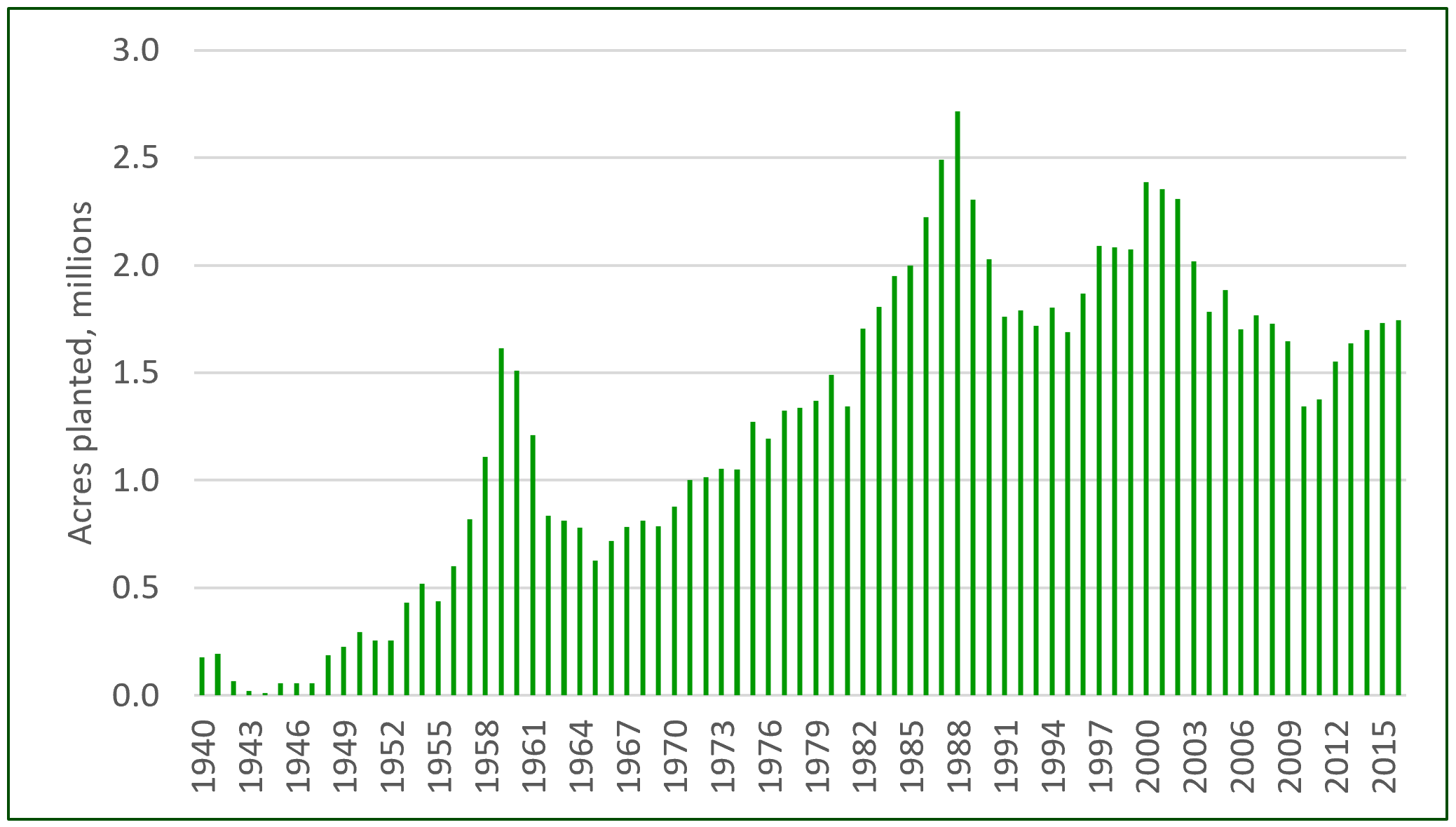Lawmakers proposed legislation last week that set a goal for the United States to support planting one trillion trees by 2050 globally to address climate change. Trees absorb and store carbon dioxide from the atmosphere, and the bill is touted by its sponsors as a way to lower atmospheric carbon, plant forests, and add jobs. How might this bill affect the U.S. timber industry?
For context, forest owners and managers plant about 1 billion tree seedlings annually in the U.S. South alone. The Trillion Trees Act calls for planting 33 billion trees per year for the next thirty years. That’s a lot of trees!
We have experience with forestry-related government incentive programs. And we already plant a lot of trees. Figure 1 below shows acres of trees planted in the U.S. South since the 1940’s. The first surge in planting activity in the 1950’s corresponds with the federally financed Soil Bank Program, which was a voluntary land retirement program for cropland. The second wave of activity in the 1980’s ties to the Conservation Reserve Program (CRP), in which the U.S. Department of Agriculture incented landowners to plant trees on former fields and agriculture lands. The effects magnified each other, as a major decrease in harvesting activity during the economic recession of 2007-2009 fed already strong forest inventories planted 30 and 60 years ago. These combined activities resulted in timber “oversupply” across the South as reflected in low and less responsive timber prices, although some local timber markets are becoming more balanced.

The bottom line for U.S. forest owners: based on our experience with previous government incentive programs, The Trillion Trees Act would not be a boon for U.S. forest owners. In fact, taken to the extreme, if it massively increased planting in the South, it would exacerbate the timber oversupply issue that plagues many timber markets in the region.

Very well said. Hard to find a way for government to interfere with markets without breaking ten things to “fix” one. Better for them to find barriers to more wood use and remove those barriers, then let markets develop freely.
Except : planting now will not yield more fibre for 15+ years. The world needs more renewables. The market for wood as a renewable feedstock (for all applications) would be encouraged by the prospect of increasing availability – so I see this as a net positive in the long run.
Where to begin with such a bad idea? In no particular order:
1. The premise is at best debatable.
2. Does the author of the proposed legislation have any idea how many trees are being planted globally annually now? I do not know but as Ms. Lang points out, in one particular region of the US we plant 1,000,000,000 trees per year. How far along is humanity already toward achieving this arbitrary planting goal?
3. Is tree planting one of the enumerated powers in the Us Constitution? A quaint notion, I concede.
4. Do the owners of the land on which these trees will be planted want trees planted on their land?
5. Who will pay for this tree planting project? Print more dollars or euros or yen or yuan or pesos?
6. The market impacts pointed out by Ms. Lang in her post.
7. Oversupply of a capital resource often (normally?) results in waste of the resource as the capital stock is drawn down to some sort of “market equilibrium” point because its marginal value is so low.
8. How was the number of one trillion trees arrived at? Is there some scientific significance to this number or is just a feel good virtue signaling number?
9. What species of trees will be planted? Are all carbon sequestering trees created equal?
10. Are we planting too many trees in the US South?